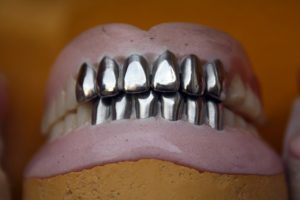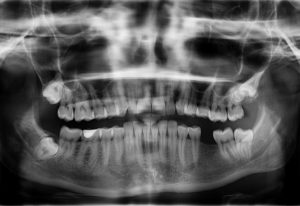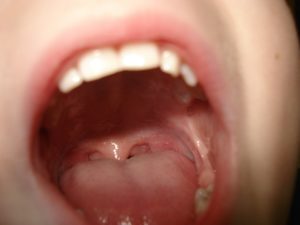Teeth Issues – Episode 104

Teething
Teething is mostly known as the phase of babies growing their first teeth. Eruption is when the tooth enamel shows through the gum tissue. A baby’s first teeth grow in between 6 months and 2 years old. Before any of the teeth show, the gums can be swollen and bumpy. These symptoms can cause fussiness, sleeplessness, drooling, decreased appetite, excessive chewing, and overall grumpiness. A few controversial symptoms include fever, diarrhea, and rash. A fever less than 100.4*F can be indicative of inflammation going on, which can be true for some teething babies. Diarrhea is blamed on excessive saliva ending up in the digestive tract (eh, many things can change the consistency of a baby’s poop, especially in the early stages where they’re only drinking milk or just learning to eat new foods). A rash is a little more questionable, but can also be a result of inflammation going on.
Treatments
Treatments for teething babies include Infant’s Tylenol or Infant’s Ibuprofen (for children older than 6 months). Other medications that used to be recommended for teething babies were Teething Tablets and Orajel. An active ingredient in the Teething Tablets is Belladonna. This medication can constrict blood vessels, which is good when there’s inflammation (increased blood flow) to an area, but bad when baby’s blood vessels are already tiny and they need to get blood to very important places (i.e. the brain). The bottom line is that Belladonna can decrease the amount of blood, and therefore oxygen to a baby’s brain, and the outcome can potentially be SIDS.
This is also true of Benzocaine, the ingredient in Orajel. Benzocaine is a topical numbing agent. The key word here is topical. It is not intended to circulate in the body. The problem comes when you use a TOPICAL product in your mouth, you can’t help but swallow some of it. When Benzocaine is swallowed, it can cause a serious side effect that involved decreased oxygen in the blood. Again, if oxygen doesn’t get to important places in the baby’s body, bad things can happen.
PSA: NO Belladonna and NO Benzocaine for babies!
Plaque
Your teeth are covered in a biofilm that is mostly made up of bacteria. That bacteria can compromise the seal that is formed between healthy teeth and healthy gums. If this seal is breached by bacteria, then infection and gum disease (gingivitis) can occur.
Tartar
Plaque can harden, and when it does, it becomes known as tartar. Mouth bacteria eat the sugars in the food that gets stuck in the crevices of your teeth. A waste product of this process is lactic acid, and lactic acid can actually dissolve enamel of your teeth. Minor erosion can be repaired by your body. The problem is that saliva cannot break through the plaque.
Cavities
Tooth decay is the result of long-term enamel erosion that can’t be repaired by the body. If the erosion is deep enough, it can expose the softer parts of the tooth to irritants and injury. When this happens, the only way to repair and protect the tooth is to get a filling from your dentist. *womp womp*
Discoloration
Extrinsic stains are when substances change the tooth color from the outside. So this is how coffee, tea, wine, and tobacco can make the teeth yellow or brown. Also, certain bacteria, excessive chlorophyll, or excess copper and nickel can make the teeth look green.
Intrinsic stains are when the building blocks of teeth are altered and changes the color from the inside. Tetracycline antibiotics have been a common treatment for acne in teenagers for quite a long time. It is well-documented that these antibiotics can bind up free calcium in the body. Therefore, it is not recommended for pregnant women or children younger than 8 years old to use these medications. There are many cases of developing fetuses and children with quickly-developing teeth ending up with grey or brown teeth due to this missing calcium (remember, calcium built into the enamel is what makes it white).
Injuries
A chipped tooth is when a part of the enamel breaks away. A fractured tooth is when a crack involves the enamel and the dentin. An abscess is an infection in the gum around the tooth or in the accessible or exposed pulp of a tooth. Luxation is a dislocated tooth, and may or may not include injury to the periodontal ligaments or jawbones.
Connect with me
Support us on Patreon
Join the Pharmacist Answers Podcast Community on Facebook
Subscribe: iTunes, Stitcher, GooglePlay, TuneIn Radio
Music Credits: Up In My Jam (All Of A Sudden) by – Kubbi https://soundcloud.com/kubbiCreative Commons — Attribution-ShareAlike 3.0 Unported— CC BY-SA 3.0 http://creativecommons.org/licenses/b…Music provided by Audio Library https://youtu.be/tDexBj46oNI



